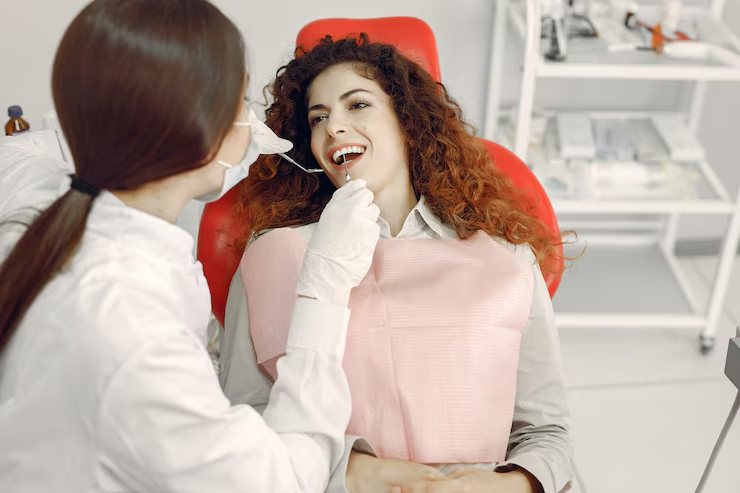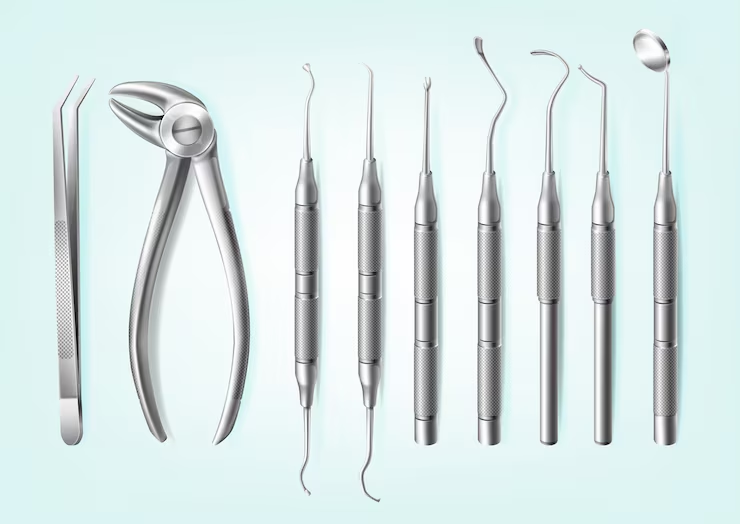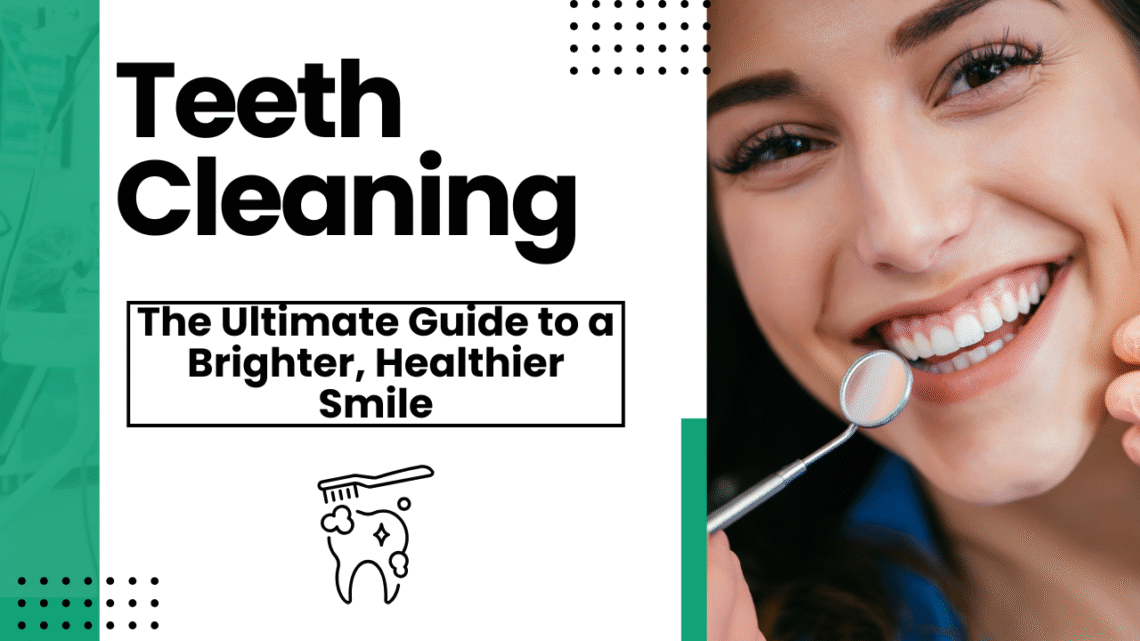Clean, healthy teeth are essential not only for a beautiful smile but also for your overall health. Teeth cleaning goes far beyond cosmetic benefits—it plays a vital role in preventing serious oral health problems such as cavities, gum disease, tooth loss, and persistent bad breath. Regular teeth cleaning also contributes to improved systemic health, as poor oral hygiene has been linked to heart disease, diabetes, and even cognitive issues like dementia.
Daily teeth cleaning practices, such as brushing and flossing, help remove food particles, plaque, and harmful bacteria that build up in your mouth. When neglected, these substances can harden into tartar and lead to gum inflammation and infection. Professional teeth cleaning by a dentist or hygienist is equally important, as it removes tartar that home care can’t reach and polishes your teeth for a healthier, cleaner finish.
Whether you’re aiming to improve your daily oral care routine or exploring the benefits of professional dental cleanings, understanding the importance of teeth cleaning is the first step to maintaining lifelong oral health. With the right techniques, tools, and habits, you can protect your smile, boost your confidence, and safeguard your overall wellness—one cleaning at a time.
In this in-depth article, we will cover:
- The importance of teeth cleaning
- How plaque and tartar affect oral health
- The difference between home and professional cleaning
- And the top 8 expert tips to keep your teeth sparkling clean and healthy.
What Is Teeth Cleaning?

Teeth cleaning is the process of removing dental plaque (a sticky film of bacteria) and tartar (hardened plaque) from the teeth. It can be done at home through regular brushing and flossing, or professionally by a dentist or dental hygienist.
Professional teeth cleaning is a crucial part of maintaining excellent oral health. Unlike routine brushing and flossing at home, professional teeth cleaning involves advanced dental tools that are designed to clean thoroughly—especially below the gumline, where plaque and tartar often accumulate. These tools can remove hardened tartar (calculus) that cannot be eliminated by a regular toothbrush, effectively reducing the risk of gum inflammation and infection.
During a professional teeth cleaning session, a dental hygienist performs scaling to eliminate plaque and tartar buildup from the teeth and around the gums. This is followed by polishing, which smooths the surface of the teeth and removes surface stains, leaving your smile clean, bright, and refreshed. Some cleanings may also include fluoride treatments to strengthen tooth enamel and prevent decay.
Why Is Teeth Cleaning Important?
Maintaining clean teeth is essential for several reasons:
🦷 1. Prevents Cavities
Plaque contains bacteria that feed on sugars and produce acids, which erode tooth enamel. Regular teeth cleaning removes plaque and prevents tooth decay.
🦷 2. Fights Gum Disease
When plaque builds up along the gumline, it can cause inflammation (gingivitis), bleeding, and even lead to gum recession and tooth loss (periodontitis).
🦷 3. Prevents Bad Breath
Bacteria and food particles trapped in your mouth produce unpleasant odors. Cleaning your teeth and tongue helps eliminate bad breath.
🦷 4. Keeps Your Smile Bright
Teeth cleaning removes stains caused by food, drinks, and tobacco, improving the appearance of your smile.
🦷 5. Supports Overall Health
Oral bacteria can enter the bloodstream and affect other organs. Good dental hygiene reduces the risk of heart disease, stroke, and diabetes complications.
How Plaque and Tartar Form
Plaque is a colorless, sticky film of bacteria that forms on your teeth and gums after eating or drinking. If not removed daily through brushing and flossing, plaque hardens into tartar (also called calculus), which can only be removed by a dental professional.
ChatGPT said:
Tartar buildup is a serious oral health concern that develops when plaque—an invisible film of bacteria on the teeth—is not removed through regular brushing and flossing. Over time, plaque hardens into tartar, which firmly attaches to the enamel and below the gumline. This hardened deposit cannot be removed by regular brushing alone and requires professional teeth cleaning by a dentist or dental hygienist.
When tartar accumulates, it can lead to gum inflammation (gingivitis), causing redness, swelling, and bleeding during brushing or flossing. If left untreated, this inflammation can progress to periodontitis, a more severe form of gum disease that can damage the bone supporting your teeth. In addition to these health risks, tartar can cause tooth discoloration, making your smile appear yellow or stained, and increase the likelihood of oral infections.
To prevent these issues, it’s essential to maintain a consistent teeth cleaning routine at home and schedule professional teeth cleaning at least twice a year. Brushing twice daily, flossing once a day, and using an antibacterial mouthwash can help minimize plaque formation. However, only professional tools can effectively remove tartar and protect your gums and teeth from long-term damage. Regular teeth cleaning is the key to maintaining a healthy, bright smile.
Types of Teeth Cleaning
- At-home teeth cleaning is the foundation of a healthy smile and essential for preventing dental problems such as cavities, gum disease, and bad breath. Consistent daily oral care helps maintain clean teeth between professional dental visits and promotes long-term oral health.
- Start with brushing your teeth twice a day using fluoride toothpaste. This removes plaque, bacteria, and food particles from the tooth surfaces. Use a soft-bristled toothbrush and brush for at least two minutes each time, paying attention to all areas of the mouth, including the tongue.
- Flossing once a day is equally important. It cleans between teeth and along the gumline—areas that a toothbrush can’t reach. Regular flossing helps prevent gum inflammation and reduces the risk of tartar buildup.
- Incorporate an antibacterial mouthwash into your routine to further reduce plaque and kill germs that cause bad breath. Choose a mouthwash with fluoride or ingredients that target gingivitis and strengthen enamel.
- Diet also plays a key role in teeth cleaning. Limit sugary snacks and acidic beverages like soda and fruit juice, as they feed harmful bacteria and erode enamel. Instead, eat a balanced diet rich in fiber, calcium, and water to naturally cleanse the mouth and support strong teeth.
- When done consistently, effective at-home teeth cleaning keeps your smile bright, your gums healthy, and your dental visits stress-free.
🔹 Professional Teeth Cleaning
Teeth cleaning is a professional dental procedure typically performed by a dental hygienist or dentist every six months to maintain oral hygiene and prevent dental issues. A standard teeth cleaning session includes several important steps designed to keep your teeth and gums healthy.
First, scaling is done to remove plaque and hardened tartar (calculus) that accumulates above and below the gumline. This step is critical, as tartar cannot be removed through brushing and flossing alone. If left untreated, it can lead to gum inflammation, infection, and even tooth loss.
Next comes polishing, where the dental professional uses a special tool and polishing paste to buff the tooth surfaces. This not only removes surface stains caused by food, beverages, or smoking but also leaves the teeth feeling smooth and looking shiny.
A fluoride treatment may be applied to strengthen tooth enamel and help prevent future decay. Fluoride acts as a protective barrier against cavities, especially for those prone to enamel erosion.
In cases of advanced gum disease, a more intensive procedure known as deep cleaning or scaling and root planing may be recommended. This targets plaque and tartar deep beneath the gums, helping to reduce inflammation and promote healing.
Regular teeth cleaning is essential for preventing gum disease, tooth decay, and maintaining fresh breath. It complements your daily brushing and flossing routine and is a cornerstone of long-term oral health..
Top 8 Tips for Better Teeth Cleaning
✅ 1. Brush Twice a Day – The Right Way

Brushing is your first line of defense against plaque and tartar. But how you brush matters.
Tips:
- Use a soft-bristled toothbrush
- Brush for at least 2 minutes
- Use fluoride toothpaste
- Brush at a 45-degree angle to the gums
- Don’t brush too hard—gentle, circular motions are best
🪥 Replace your toothbrush every 3 months or when bristles fray.
✅ 2. Floss Daily to Clean Between Teeth
Brushing alone misses about 35% of your tooth surfaces. That’s where flossing comes in.
Tips:
- Floss at least once a day
- Use gentle up-and-down motions
- Curve the floss around each tooth
- Consider floss picks or water flossers if traditional floss is difficult
Flossing removes food particles and plaque between teeth and under the gumline—places your brush can’t reach.
✅ 3. Use Antibacterial Mouthwash
Mouthwash can reach areas that brushing and flossing might miss. It helps:
- Kill bacteria
- Freshen breath
- Reduce plaque
- Prevent gum disease
Look for a therapeutic, alcohol-free mouthwash that contains fluoride or antibacterial agents like chlorhexidine or cetylpyridinium chloride.
✅ 4. Visit Your Dentist Every 6 Months

Professional cleanings are essential for removing tartar and monitoring your oral health. Regular dental visits help:
- Detect cavities early
- Prevent gum disease
- Address alignment or bite issues
- Monitor oral cancer and other risks
Don’t wait for pain—preventive care is easier and less expensive than treatment.
✅ 5. Limit Sugary and Acidic Foods
Sugar feeds harmful bacteria, while acidic foods erode enamel. Limiting these helps protect your teeth.
Tips:
- Avoid frequent snacking on sweets
- Drink water after acidic foods or beverages
- Use a straw to minimize contact with teeth
- Include tooth-friendly foods like dairy, crunchy veggies, and green tea
Balanced nutrition supports both oral and overall health.
✅ 6. Clean Your Tongue Daily
Your tongue harbors bacteria that can lead to bad breath and plaque.
Tips:
- Use a tongue scraper or your toothbrush to clean your tongue daily
- Start from the back and move forward
- Rinse thoroughly after scraping
A clean tongue supports a healthier mouth and fresher breath.
✅ 7. Use Dental Tools Wisely

In addition to a toothbrush and floss, other tools can enhance your cleaning routine:
- Electric toothbrushes: Offer superior plaque removal
- Interdental brushes: Ideal for larger gaps
- Water flossers: Great for braces or sensitive gums
- Whitening toothpaste: Helps remove surface stains
Consult your dentist to find the right tools for your needs.
✅ 8. Don’t Ignore Bleeding Gums
Bleeding while brushing or flossing is often a sign of early gum disease. Don’t ignore it.
Tips:
- Continue brushing and flossing gently
- Use antibacterial mouthwash
- Apply a warm salt water rinse
- Visit your dentist for evaluation
Catching gum issues early can prevent them from progressing into serious conditions like periodontitis.
Myths and Facts About Teeth Cleaning
❌ Myth: You only need to clean your teeth if they feel dirty
✔️ Fact: Plaque is invisible and constantly forming—even when your mouth feels clean.
❌ Myth: Professional cleaning wears down your teeth
✔️ Fact: Dental cleaning removes tartar, not enamel. It’s safe and necessary.
❌ Myth: Bleeding gums mean you should stop flossing
✔️ Fact: Bleeding often means your gums need more, not less, care.
Signs You Need Professional Teeth Cleaning
- Bad breath that doesn’t go away
- Yellow or brown tartar buildup
- Bleeding, swollen, or receding gums
- Tooth sensitivity
- Loose teeth
Don’t delay—early treatment can save your teeth and gums.
Teeth Cleaning for Children and Teens
Good habits start early. Teach children:
- To brush twice daily with supervision
- How to floss as soon as two teeth touch
- To avoid sugary snacks and drinks
- To visit the dentist by age 1 or when the first tooth erupts
Teenagers with braces need extra care to clean around brackets and wires.
Teeth Cleaning for Adults and Seniors
As we age, oral care needs change:
- Dry mouth becomes more common, increasing cavity risk
- Gum recession exposes roots and causes sensitivity
- Medications can affect saliva flow
Seniors should use fluoride toothpaste, stay hydrated, and maintain regular cleanings to protect their smiles.
Final Thoughts: A Healthy Smile Starts With Clean Teeth
Clean teeth offer more than just a confident, radiant smile—they are a cornerstone of good health and overall well-being. When you commit to regular teeth cleaning, you’re not only improving the appearance of your teeth but also enhancing how they function and protecting your long-term health. Clean teeth feel smoother, are less sensitive, and are far more resistant to decay and gum disease. More importantly, a clean mouth helps reduce the risk of serious health problems such as heart disease, diabetes complications, and respiratory infections, all of which have been linked to poor oral hygiene.
Whether you’re already following a dental routine or seeking to improve it, the foundation of success lies in consistency. Brushing your teeth twice a day with fluoride toothpaste, flossing daily, and using an antibacterial mouthwash are essential at-home steps for effective teeth cleaning. These habits prevent plaque buildup, reduce the risk of tartar formation, and keep your breath fresh.
However, at-home care should always be complemented by professional teeth cleaning at least twice a year. Dental professionals use specialized tools to remove stubborn tartar and polish your teeth, reaching areas that brushing and flossing can’t. This combination of daily care and regular professional maintenance helps ensure your teeth not only look their best but also remain strong and healthy for life.
In short, teeth cleaning is more than a cosmetic habit—it’s a vital part of living a healthier, longer, and more comfortable life. Make it a priority, and your smile will thank you every day.
By brushing, flossing, eating smart, and seeing your dentist regularly, you’re investing in more than just oral health—you’re boosting your confidence, comfort, and overall well-being.
✅ Quick Recap: Top 8 Teeth Cleaning Tips
- Brush twice daily with the right technique
- Floss every day to reach hidden areas
- Use antibacterial mouthwash for added protection
- Get professional cleanings every 6 months
- Limit sugar and acidic food intake
- Clean your tongue to reduce bacteria
- Choose the right dental tools
- Don’t ignore bleeding gums—act early
Here are 5 Frequently Asked Questions (FAQ) about Teeth Cleaning:
1. How often should I get professional teeth cleaning?
Answer:
It’s recommended to have professional teeth cleaning every six months. However, some people with gum disease, tartar buildup, or other oral health concerns may need more frequent cleanings as advised by their dentist.
2. Does teeth cleaning hurt?
Answer:
For most people, teeth cleaning is painless and simply feels like a thorough polishing of the teeth. You may experience mild discomfort if you have sensitive gums or excessive tartar, but your dental hygienist can adjust the procedure or apply numbing gel if needed.
3. What is the difference between plaque and tartar?
Answer:
Plaque is a soft, sticky film of bacteria that forms on your teeth daily. If not removed through brushing and flossing, it hardens into tartar, which can only be removed through professional teeth cleaning.
4. Can teeth cleaning whiten my teeth?
Answer:
Teeth cleaning removes surface stains from food, beverages, and tobacco, which can make your teeth appear whiter and brighter. However, it doesn’t change the natural color of your teeth like professional whitening treatments do.
5. Is teeth cleaning necessary if I brush and floss daily?
Answer:
Yes. Even with excellent daily hygiene, plaque can still harden into tartar in hard-to-reach areas. Professional teeth cleaning is essential for removing tartar and preventing gum disease, ensuring optimal oral health.





